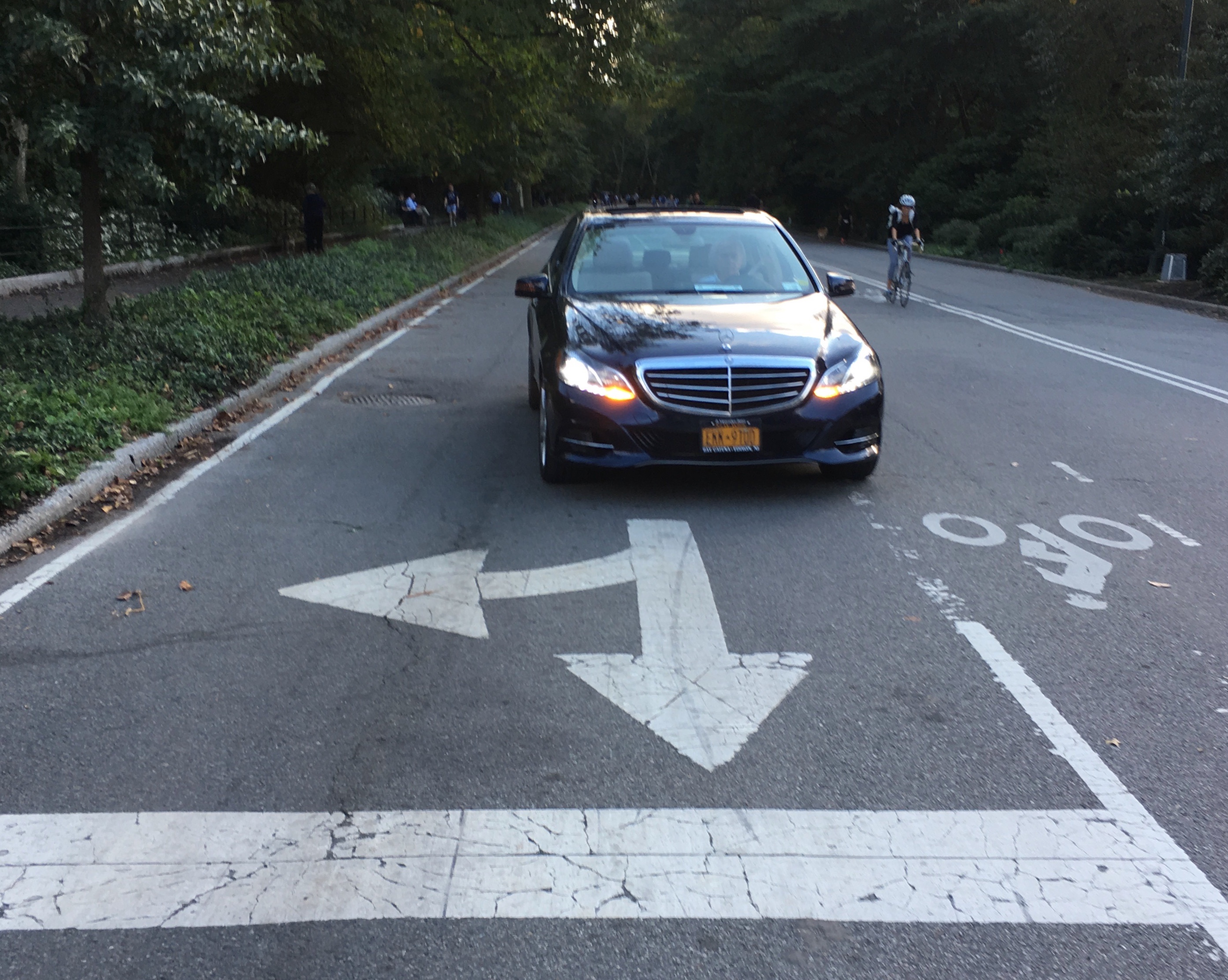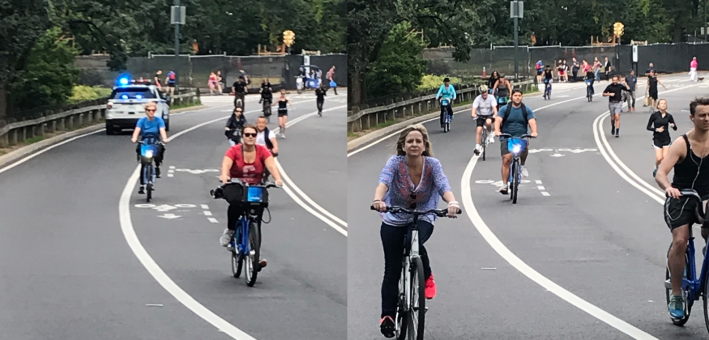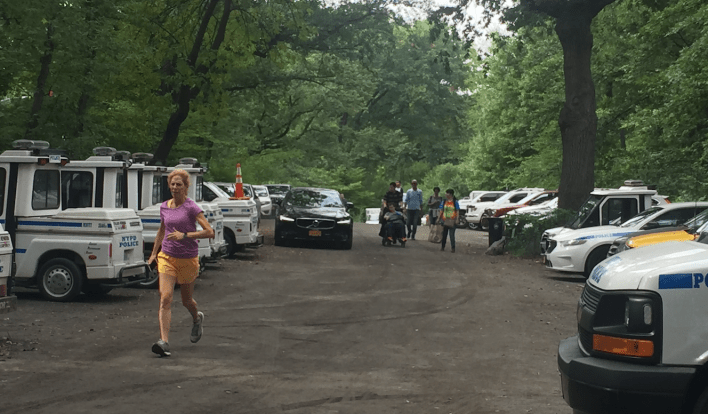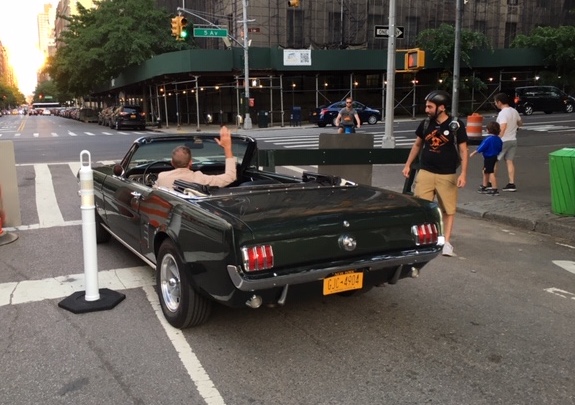Not-So-Car-Free: Drivers Still Reign In Supposedly Auto-Less Parks
12:01 AM EDT on October 10, 2018

A car in Central Park, pictured last week — more than three months since the park went “car-free.” Photo courtesy Bill Amstutz, used with permission
Car-free Central Park is anything but.
Three months after city officials hailed a new era for pedestrians and cyclists to be safe from 2,000-pound vehicles, the city has authorized a long list of drivers who can still motor through the park — and do so all day and night, fraying the nerves of park users.
"It's only a matter of time whether something happens when somebody gets injured," said Upper West Side cycling activist Willow Stelzer.
Drivers once had unfettered access to the park roadways, but the city scaled back those hours after a concerted, 50-year push by advocates, first banning cars above 72nd Street in 2015, and then, this year, closing off the rest of the greensward.
The goal was to give cyclists, pedestrians, joggers and birders additional space on the crowded drives. But regular park-goers say that hasn't happened. One lane continues to be used by city employees and other drivers, who insist that pedestrians and cyclists get out of their way — often at unsafe speeds.
And often, these drivers are going the wrong way on the counter-clockwise loop (see below).

The continued presence of cars in the parks isn't just a nuisance, it's dangerous. By maintaining the right-hand lane for cars, park management is effectively limiting the amount of space for growing numbers of pedestrians and cyclists. Stelzer said she has seen Central Park Conservancy vehicles bully tourists and park-goers out of the lane, turning peaceful walks into mad scrambles. Speeding NYPD cruisers are a regular occurrence, often against the direction of traffic.
"People who are enjoying the park don't expect to see them, and I think they don't expect that the right-hand lane is actually where cars will be," Stelzer said. "It happens so suddenly."
Most of the cars in the park are city-owned, but not all. Many are bound for Parks and NYPD staff parking lots within the park.
"I've noticed lots of private cars," said East Sider Albert Ahronheim. "Either parks employees or police unmarked cars or something."
When asked why there are so many cars in a supposedly car-free park, the Parks Department gave Streetsblog its extensive list of cars that are exempted from the rules — a form of placard abuse that includes:
- NYC Parks, Prospect Park Alliance and Central Park Conservancy vehicles used by staff in the course of maintaining and operating Central Park.
- Commercial vehicles authorized by Parks to provide delivery, garbage pickup, recycling pickup, landscaping, construction, or maintenance services pertaining to the maintenance and operation of Central Park and activities related to Parks concession spaces and special events.
- Personal vehicles with a permit from Parks or a permit approved by Parks from a licensed Parks concessionaire to access Central Park to provide services pertaining to the maintenance and operation of Central Park and its concessions spaces and special events.
- Vehicles approved by Parks to facilitate access to Central Park for individuals with disabilities.
That list did not specifically mention NYPD vehicles or, more important, vehicles driven by NYPD employees, who are also allowed to drive into the park. The "Bridle Path" below the reservoir is littered with both patrol vehicles and placard-wielding personal cars:

"The officers need to get work. Obviously, they need to use the park to get to work," Detective Ahmed Nasser, an NYPD spokesperson, told Streetsblog. "They need police cars to patrol."
It is unclear why. Police officers are no different from the millions of other workers who commute in and to New York City every day, the vast majority of them on public transit. And the Central Park Precinct is inarguably one of the safest in the city, with overall crime down 90 percent over the last 25 years. If any precinct could eliminate patrol cars in favor of cops on bikes or in smaller, Cushman-style vehicles, it is the Central Park Precinct.
A call to the precinct's commanding officer, Captain Peter Andrea, was not returned. When I stopped by the station house, I was told to call the public information office.
"When the big change came, it was pretty bad for a couple of months," Greenberg said. "I think the word came down from NYPD that you can’t do this. Now, it’s mostly drips and drabs."
It was so hot Tuesday night but it was 5 degrees cooler in @prospect_park. I wanted to do a couple laps. I love that it's "car free" now but I can't deny I was a little startled by the @NYPD78Pct when they passed me. I wonder if it's possible for them to patrol the park on ebike? pic.twitter.com/LJyMbnxNwK
— JarekFA (@JarekFA) July 12, 2018
The city also turned the Park Circle entrance into a pedestrian-priority "shared space," with gravel epoxy. Work is now underway at the Grand Army Plaza entrance, but similar improvements are not currently planned for Central Park's entrances, DOT spokesperson Alana Morales said.

Ahronheim, who joined the car-free Central Park campaign shortly after he moved to the neighborhood in 2000, has a list of proposals for the Manhattan park: remove traffic lights from the drives, allow cyclists and pedestrians to use the right-hand when emergency vehicles are not present, shift city employees to smaller vehicles, and more. Naturally, he'll also be asking Parks and NYPD employees to leave their personal cars at home.
"I've always been distressed with how carelessly Parks employees drive their legal cars in the park," he said. "In my opinion, they should not go any faster than bicyclists."
The continued presence of cars in the park disappoints Ahronheim, who helped usher the last car out of the park with a car-free spin on the Rolling Stones’ “The Last Time.”
“This will be the last car,” he sang on June 27. “How do we know? Bill de Blasio! Thank you, Mister Mayor!"
Last week, Ahronheim had changed his tune. "I was sadly premature," he said.
This Thursday, October 11, the Central Park Conservancy will host a public "Recreation Roundtable" on the subject of "the demands and challenges of increased use on the Drive now that the Park is car-free." The meeting starts at 6:30 p.m. at North Meadow Recreation Center, located mid-park at 97th Street.
Update (10/11/2018): The meeting has been postponed due to inclement weather.
David was Streetsblog's do-it-all New York City beat reporter from 2015 to 2019. He returned as deputy editor in 2023 after a three-year stint at the New York Post.
Read More:
Stay in touch
Sign up for our free newsletter
More from Streetsblog New York City
Adams Backs Lower Speed Limits, Calls Crashes ‘Accidents’
The mayor wants New York City drivers to "slow down," but it's not clear yet how many streets will get lower speed limits.
Wednesday’s Headlines: Trump Posts About Congestion Pricing Edition
Donald Trump comments on congestion pricing — no surprise, he's against it. Plus more news.
DOT Aims to Build First Ave. Tunnel Bike Lane Before September’s UN General Assembly
DOT hopes to have the concrete-protect tunnel bike lane installed this summer, but its exact plans are still in development.
Waste Reforms Could Require Data on Crashes, Dangerous Driving
The proposal affects at least one trucking company with a deadly driving record.
When it Comes to Federal Infrastructure Grants, Size Does Matter
Cities and municipalities with larger budgets and staff are more likely to win competitive federal infrastructure grants, the Urban Institute has found.




